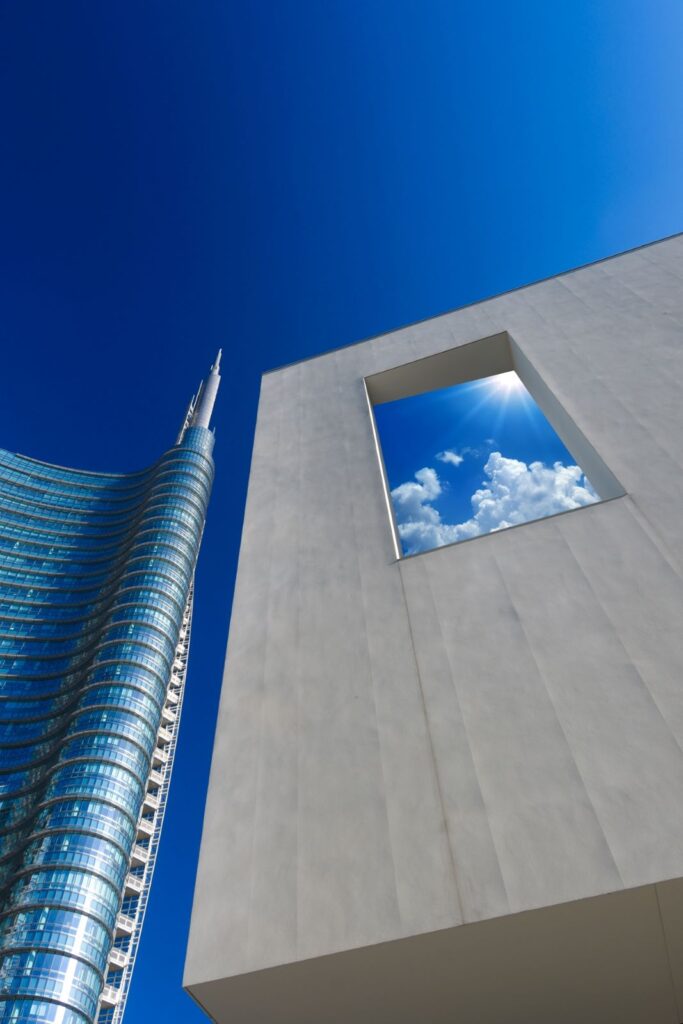Inaugurated in February 2014, the Unicredit Tower in Milan, designed by Argentine architect César Pelli, has quickly become one of the symbols of the Porta Nuova district and more generally of the economic and urban renaissance that has characterized the recent years of the Italian city. It is no coincidence, therefore, that the Unicredit Tower itself is the protagonist of the New Buildings prize winning shot, promoted in 2020 by Matrix4Design in collaboration with Urban Photo Awards. A photograph made unique by the ability to capture the balance between architecture, light and perspective in order to fully communicate the impact of the building on the urban landscape. To discover more, we decided to interview Rebeka Legović, author of the shot and professional photographer.

What is the origin of the photograph of the Unicredit Tower in Milan, winner of the New Buildings award? Is it the result of a sudden intuition or a prolonged study?
The photo of the Unicredit Tower in Milan was born by chance. Each of my photographs is usually the result of prolonged study, careful observation of light and shapes. This one, instead, was born during a walk. Fortunately that day I was carrying my camera with me and it was the first time I visited the Porta Nuova district in Milan, so I still didn’t know the best perspectives and the play of light that could have been created. I was fascinated by the majestic shapes and I started shooting. Obviously, when you find yourself completely unprepared in a certain place and you can bring home a satisfying shot, in most cases I would say that it’s not just luck, but you also have the ability to use all the knowledge you have and make the most of it in those circumstances.
Architecture, light, perspective: which element had more weight in the shot?
Architecture speaks with a language that uses a grammar made of shapes, colors, relationship between empty and full, contrasts of light and volumes in absolute silence. All this needs to be interpreted in images in order to give it a voice. This particular shot was born from the fusion of these elements, which had the same weight during the elaboration.
As far as the light is concerned, I would say that it feeds on diffuse clarity but also on ambiguous shadows that cut and separate surfaces, and can reveal how space works in relation to the urban context and the multiple identity of a particular building. The effects of light in architectural photography usually cannot be forced but can accommodate the expressive potential. The possibility to see is given to us by light, and light is the strongest link between photography and architecture. Taking a photo is nothing more than capturing on a film, or on a sensor, light, the same light that creates and generates space. If the word “photography” means writing with light, we could say that making architecture is nothing more than modeling through light.
We cannot forget the profound relationship that architecture and light have with perspective, which has significant effects on the perception of the image. Perspective directs the eye of the observer towards a particular point in the frame. The more intelligent a composition will be, the more perspective will direct the eye towards what is really significant about the image and therefore it is necessary to use this aspect wisely. In conclusion, architecture, light and perspective complement each other.
What does this victory mean to you?
I am honored that a magazine like Matrix4Design has chosen my photography as the best one in the competition. It is a great recognition for the work I am doing especially in the field of architectural photography. The latter, together with fashion photography, has always been the focus of my interest. It is also a great satisfaction that for the second year in a row my name is among the winners of URBAN Photo Awards.
I want to dedicate this victory to my teacher and friend, Professor Guido Cecere, who loved this shot so much and always encouraged me not to give up.
How would you describe the relationship between photography and architecture?
Within the architectural disciplines, photography has assumed an increasingly central role. First of all, it constitutes a fundamental tool for the narration of the project: it is the document that reproduces the objective reality of architecture, fixing it in time and space at the service of collective memory, but it is also the privileged means of personal interpretation and reworking of the message that a work of architecture conveys. Architecture is created by the architect, but if we see it through a photograph it is also created by the photographer.
Photography has always been in dialogue with urban and architectural theories, and helps to clarify and spread them. The 2000s have shown how an architectural object can become media material and the photographer is the one who is able to capture and highlight the power of image that architecture possesses. That was the period of the exaltation of the photogenic power of projects, when the image dominated the built space. Since then, the situation has evolved, moving towards maturity, a greater awareness of the photographic language also in this field.
There are therefore two distinct and complicit entities that are architecture and photography. The photographic shot, in the very instant in which it is impressed, becomes the spokesman of two languages: that of the photographer through photography itself and that of the architect through architecture. In this process, which presupposes humility to understand, study to know, time to listen and technique to realize, lies the fascination of photographic work.

In your opinion, what are the distinctive features of your photographs? What makes them recognizable? What is the message you want to convey?
I can’t do without architecture, and I can’t do without fashion. I use both photographic genres to express my visions, often creating an interesting crossover between architecture and fashion. I am attracted to design and clean lines, and how light interacts with the surrounding space. I love minimalism, powerful colors and an evocative composition. I am constantly looking for places that can turn into worlds where the rules are very different, practically an opportunity to escape the visual routine. I usually portray impressive structures in contrast to the human figure, the sky and clouds. The latter are often present in my works and represent the metaphysical, the ephemeral, a meeting point between the palpable and the immaterial, between conscious and subconscious, between the evocative and the subliminal, a dreamlike meta-reality in which real and surreal confront each other.
When I immortalize timeless spaces, shaped by the interaction of light, colours and volumes, the intention is to give body to my most intimate visions. I often distance myself from the realistic representation of the building and the human figure by adopting a style that approaches graphics or painting. Consequently, I have noticed that many images arouse doubts, questioning the photographic language itself.
My style has certainly emerged over time. It’s something I unconsciously worked on. It’s important to find your own way, but nothing comes under duress. I think an image should stimulate the viewers to create their own story, and probably everyone creates a different one. I don’t think a good photograph should tell a single definitive story.
As you mentioned earlier, in your career as a photographer you deal not only with architecture, but also with fashion and landscape. Is there something that these three areas of your work have in common?
Architecture and fashion are now two photographic languages that I often and willingly try to merge. Landscapes are another passion of mine. Exploring the planet we live on with my camera is one of the most fascinating and overwhelming adventures. In my case, fashion, architecture and landscape are united by the desire to build completely surreal visions and scenarios, strongly characterized by a metaphysical allure, as much in the choice of urban geometries as in the sublimation of natural landscapes. My desire is to present and transmit to the spectator a dimension that until then had been unimaginable, a perturbing new identity of the real.
In short, what is photography for you?
For me photography is a kind of meditation. It is pure passion in which I lose track of time, and sometimes, even if you wouldn’t say so, of space.
The winning photograph of the 2020 New Buildings prize will be exhibited together with the other nine finalist photographs on the occasion of the New Buildings photo exhibition scheduled from 28 September to 10 October 2020, during Milano Design City, at Solferino lab, the Milanese showroom of Fima Carlo Frattini, Megius and Scarabeo in via Solferino 36. The exhibition will open on September 28th at 6 pm with a special event. Don’t miss it!


